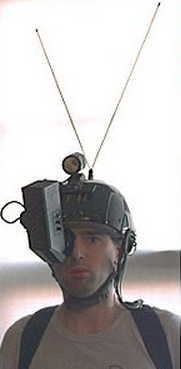Has wearable computing found its killer app?

Is wearable computing on the verge of its killer app? Its killer form factor?
While authentication isn't an app per se, it could be the feature and function that straps wearable computers on the mass market.
Just like VisiCalc drove the Apple II, email the personal computer, iTunes the iPhone and Halo the Xbox, if wearable computing wants to go mainstream it needs a sponsor.

The ability to securely log-on and communicate with devices and applications around you without end-user interaction speaks to users who would like to eliminate their cache of multiple and often insecure and stolen passwords.
Last week's stories on the Nymi wristband, and its promise of a heartbeat authenticator that attaches users to the objects around them, set fingers typing across the Internet and social media.
It joins other options such as InteraXon's Muse, an electroencephalograph (EEG) headband that records brainwaves and could be used as a think-and-authenticate device. Its form-factor, however, is not as stylish as a wristband.
Nymi, by Bionym, uses an electrocardiogram (ECG) sensor, which records the user's cardiac rhythm, which is unique to each individual.
CNET: Nymi bracelet uses your heartbeat as a password
Researchers at the Department of Electrical Engineering at Taiwan’s National Chung Hsing University also are using ECG inputs to build encryption keys to protect data and images, and secure digital communication. The form-factor, however, is not wearable, but could likely piggy-back on a device such as Nymi.
Both the Muse and the Nymi come with an SDK that will need to attract developers. But nothing attracts developers like an engaged mass market willing to spend money.
It seems there would be ample appeal to digital natives and converts, as well as, corporate executive and compliance officers for secure, no-manual-input authentication along with automated file and communication encryption from a device one just simply wears.
With the number of digital devices and Internet entry points expanding, with roaming corporate computing, and the coming Internet of Things a wearable authenticator could be the device to truly upset realities around convenience vs. security. The possibilities for streamlined, secured computer-based interaction are endless - unlock your phone, your laptop and your personal app catalog just by being close to them.
Featured
Is this end-user frustration and wearable innovation a perfect storm brewing for a killer app, or just more rain on the wearable computer parade that has been on a wet slog for decades?
Such an authentication device has a much broader appeal than other wristbased wearable computers such as the Nike+ FuelBand, Fitbit Flex, and Jawbone UP, which are finding a home with fitness buffs but are of little interest to couch potatoes.
Cyborg contraptions from the 1980s (see picture) have given way to among others Google Glasses, last year's Pebble sensation, and Meta SpaceGlasses, a safety goggle form-factor with 3-D capabilities whose chief scientist is the father of wearable computers, Steve Mann (who is also helping on InteraXon's Muse).
Mass appeal, however, is elusive. The eyeware has fostered its own set of trepidations, mostly from people who are standing in front of them rather than wearing them. Not to mention how clumsy and obtrusive they look.
Smartwatches, like the Pebble and last week's introduction of Samsung's Galaxy Gear and Qualcomm's Toq, are already being called yesterday's format by some, including my fellow ZDNet blogger Steven Vaughan-Nichols.
All of these form-factors and their applications have hit snags on the way to mass appeal. Is wristband authentication the next sacrificial lamb at wearable's alter, or could an Internet population fatigued by password problems fuel the killer app that loads up the wearable-computer bandwagon?